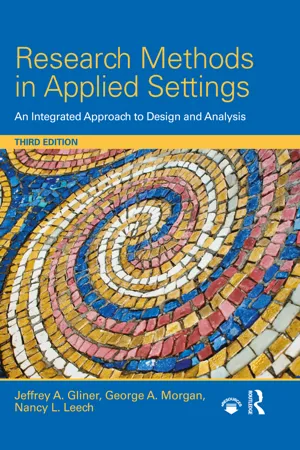
Research Methods in Applied Settings
An Integrated Approach to Design and Analysis, Third Edition
- 598 pages
- English
- ePUB (mobile friendly)
- Available on iOS & Android
Research Methods in Applied Settings
An Integrated Approach to Design and Analysis, Third Edition
About this book
This text teaches readers how to plan, conduct, and write a research project and select and interpret data through its integrated approach to quantitative research methods. Although not a statistics book, students learn to master which technique to use when and how to analyze and interpret results, making them better consumers of research. Organized around the steps of conducting a research project, this book is ideal for those who need to analyze journal articles. With teaching experience in various departments, the authors know how to address the research problems faced by behavioral and social sciences students. Independent sections and chapters can be read in any order allowing for flexibility in assigning topics.
Adopters applaud the book's clarity and applied interdependent approach to research. The book emphasizes five research approaches: randomized experimental, quasi-experimental, comparative, associational, and descriptive. These five approaches lead to three kinds of research designs which lead to three groups of statistics with the same names. This consistent framework increases comprehension while avoiding confusion caused by inconsistent terminology. Numerous examples, diagrams, tables, key terms, key distinctions, summaries, applied problems, interpretation questions, and suggested readings further promote understanding.
This extensively revised edition features:
- More examples from published research articles to help readers better understand the research process.
- New Research in the Real World boxes that highlight actual research projects from various disciplines.
- Defined key terms in the margins and interpretation questions that help readers review the material.
- More detailed explanations of key concepts including reliability, validity, estimation, ethical and bias concerns, data security and assumptions, power analysis , and multiple and logistic regression.
- New sections on mediation and moderation analysis to address the latest techniques.
- More coverage of quasi-experimental design and qualitative research to reflect changing practices.
- A new appendix on how to write about results using APA guidelines to help new researchers.
- Online resources available at www.routledge.com/9781138852976 that provide instructors with PowerPoints, test questions, critical thinking exercises, a conversion guide, and answers to all of the book's problems and questions. Students will find learning objectives, annotated links to further readings and key concepts, and key terms with links to definitions.
Intended for graduate research methods or design or quantitative/experimental research methods courses in psychology, education, human development, family studies, and other behavioral, social, and health sciences, some exposure to statistics and research methods is recommended.
Frequently asked questions
- Essential is ideal for learners and professionals who enjoy exploring a wide range of subjects. Access the Essential Library with 800,000+ trusted titles and best-sellers across business, personal growth, and the humanities. Includes unlimited reading time and Standard Read Aloud voice.
- Complete: Perfect for advanced learners and researchers needing full, unrestricted access. Unlock 1.4M+ books across hundreds of subjects, including academic and specialized titles. The Complete Plan also includes advanced features like Premium Read Aloud and Research Assistant.
Please note we cannot support devices running on iOS 13 and Android 7 or earlier. Learn more about using the app.
Information
Introductory Chapters
1
Definitions, Purposes, and Dimensions of Research
Definitions of Research
Purposes of Research
- Does class size affect student outcomes?
- Is cooperative learning more successful than individualized learning?
- Do students with special needs do better if mainstreamed into the school system?
- Does a particular treatment work?
- Are certain characteristics of therapists more effective than others?
- Is supported employment more successful for community integration than sheltered work?
Increasing the Knowledge Base of the Discipline
Theory Development
Practical Application
Development of Research Tools
Increasing Your Self-Knowledge as a Professional
Research Dichotomies
Table of contents
- Cover Page
- Half Title Page
- Dedication
- Title Page
- Copyright Page
- Content
- Contents
- Preface
- Acknowledgements
- List of Contributors
- Introductory Chapters
- 1 Definitions, Purposes, and Dimensions of Research
- 2 Planning a Quantitative Research Project
- Quantitative Research Approaches, Questions, and Designs
- 3 Variables, Research Questions, and Hypotheses
- 4 Research Approaches
- 5 Randomized Experimental and Quasi-Experimental Designs
- 6 Single-Subject Designs
- 7 Nonexperimental Approaches/Designs
- 8 Internal Validity
- Sampling, Measurement, and Data Collection
- 9 Sampling and Intr@duction to External Validity
- 10 Measurement and Descriptive Statistics
- 11 Measurement Reliability
- 12 Measurement Validity
- 13 Types of Data Collection Techniques
- 14 Ethical Issues in Conducting the Study
- 15 Practical Issues in Data Collection and Coding
- Data Analysis and Interpretation
- 16 Making Inferences from Sample Data I: The Null Hypothesis Significance Testing Approach
- 17 Making Inferences from Sample Data II: The Evidence-Based Approach
- 18 General Design Classifications for Selection of Difference Statistical Methods
- 19 Selection of Appropriate Statistical Methods: Integration of Design and Analysis
- 20 Data Analysis and Interpretation: Basic Difference Questions
- 21 Analysis and Interpretation of Basic Associational Research Questions
- 22 Analysis and Interpretation of Complex Research Questions
- Evaluating and Writing Research Reports
- 23 Evaluating Research Validity: Part I
- 24 Evaluating Research Validity: Part II
- 25 Evaluating Research for Evidence-Based Practice
- 26 Writing the Research Report
- appendix1
- appendix2
- appendix3
- appendix4
- appendix5
- appendix6
- appendix7
- reference
- Index
- Index